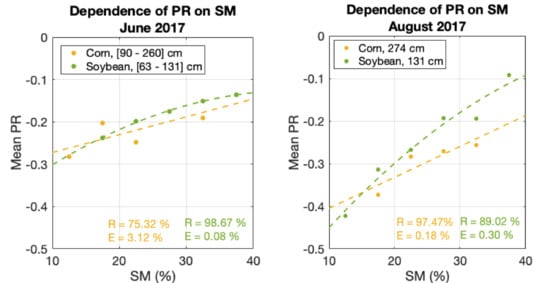The Polarimetric Sensitivity of SMAP-Reflectometry Signals to Crop Growth in the U.S. Corn Belt
Abstract
:1. Introduction
2. SMAP-R Measurements Description
2.1. SMAP-R Calibration
- is the DDM received power distribution at each delay and Doppler bin.
- is the coherent integration time. = 25 ms for SMAP-R data, instead of the typical value of 1000 ms used in other GNSS-R missions.
- is the GPS transmitted power.
- is the GPS transmitter antenna gain.
- is the GPS signal wavelength (at GPS-L2C is 24.42 cm).
- corresponds to the distance from the transmitter specular point.
- corresponds to the distance from the receiver to the specular point.
- is the SMAP antenna gain value at the specular point incidence angle . It is computed from eqn. (2), where we assume the gain presents a linear decay within the −3 dB beam width (2.7 deg.) that goes from its maximum value ( = 36 dBi @ 40 deg. incidence angle pointing) to 33 dB.
- is the filtered effective surface scattering area. It is computed following the methodology described in [15], where the size of the area corresponding to each and bin filtered by the SMAP antenna is normalized to the size of the same and bin considering an omnidirectional antenna.
- Calibration of the direct power information (). is calibrated by collocating CYGNSS information for the same day of measurements.
- Calibration of the SMAP antenna filtering effect ().
2.2. The Observable: Polarimetric Ratio
- is the delay at the bin of the DDM peak.
- is the frequency Doppler at the bin of the DDM peak.
- is the DDM received power at H-polarization measured by SMAP-R at .
- is the DDM received power at V-polarization measured by SMAP-R at
3. Methodology
- SMAP-R data preparation: computing PR and gridding the data.
- Use of ancillary datasets: gathering information on roughness, SM, and crop type using it to filter and bin the PR observable.
- Sensitivity analysis: Analyze PR observable against reference datasets; i.e., VWC, VOP, NDVI, and crop height.
3.1. Two-State Analysis Strategy
3.2. Ancillary Datasets
3.3. Reference Datasets
4. Sensitivity Analysis
4.1. PR Sample Distribution
4.2. Variability of the PR during the Crop Season
4.3. Sensitivity of the PR to the Crop Growth Parameters
PR and Crop Height Dependency
PR and VWC Dependency
PR and VOP Dependency
PR and NDVI Dependency
Conclusions on Sensitivity to Crop Growth Parameters
5. Discussion
6. Conclusions
- The SMAP-R PR observable showed a dependency on SM, regardless of the crop growth stage (Figure 15).
- ⚬
- For bare soil conditions, we observed a linear behavior of the SMAP-R PR observable (Figure 15a,d).
- ⚬
- The different crop growth stages had an impact on the dynamic range of the SMAP-R PR observable.
- The SMAP-R PR observable showed a degree of correlation with crop height, but it was not the main driver:
- ⚬
- As the crops reached their maximum height and started to dry, the crop height did not have any impact.
- ⚬
- Different crops did not display the same slope and PR values for the same crop height.
- The SMAP-R PR observable showed a linear dependency on crop growth parameters:
- ⚬
- PR decayed at a mean rate of −0.054 per kg/m2 of VWC. Applying an SM binning of the data, a 9% uncertainty was obtained (Section 4.3), i.e., 0.36 kg/m2.
- ⚬
- PR decayed at a mean rate of −0.37 per unit of VOP. Applying an SM binning of the data, a 6% uncertainty was obtained (Section 4.3).
- ⚬
- PR decayed at a mean rate of −0.23 per unit of NDVI. Applying an SM binning of the data, an 8.5% uncertainty was obtained (Section 4.3).
Author Contributions
Funding
Acknowledgments
Conflicts of Interest
Appendix A
SM Maps


NDVI Maps
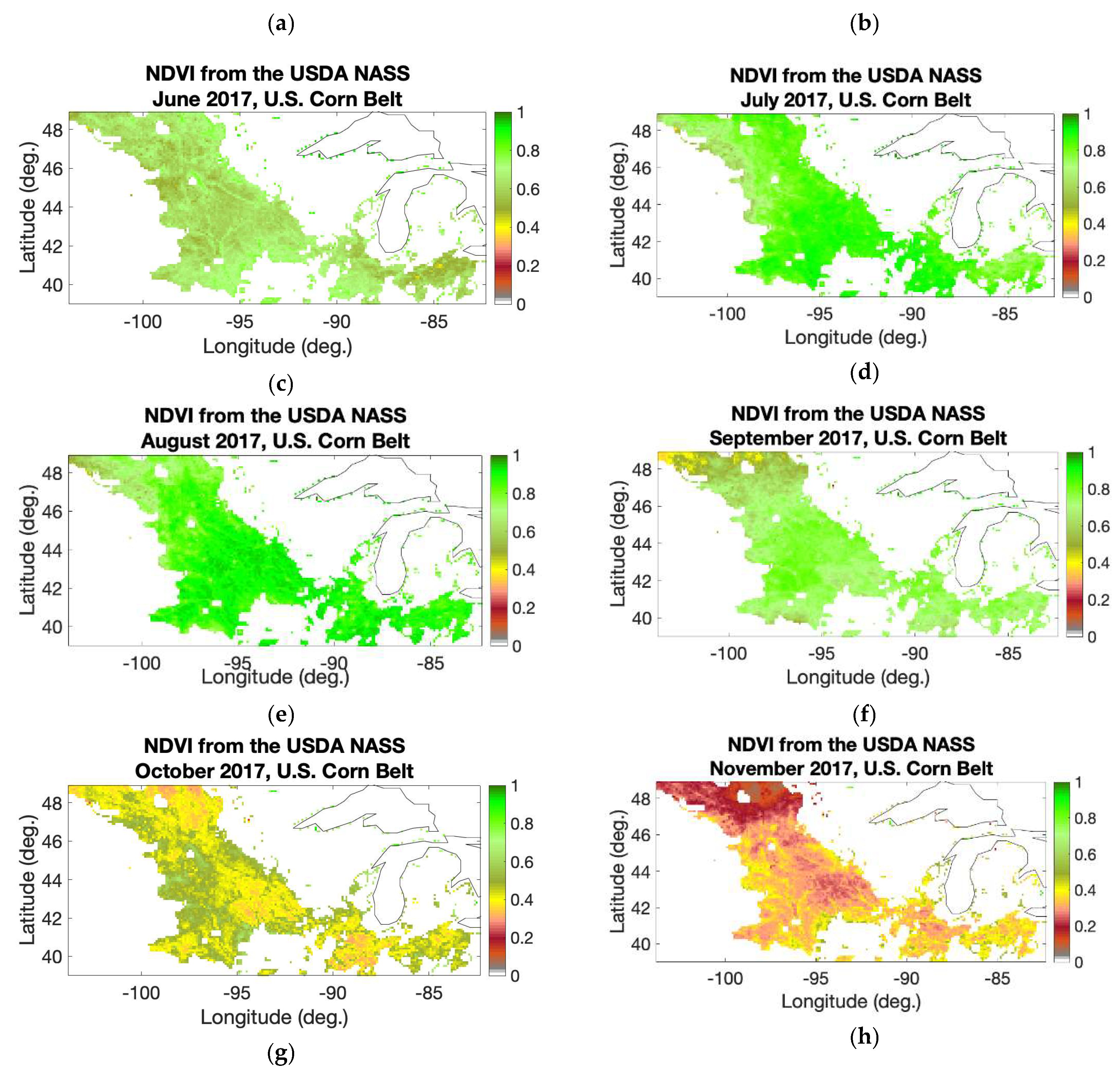
VWC Maps
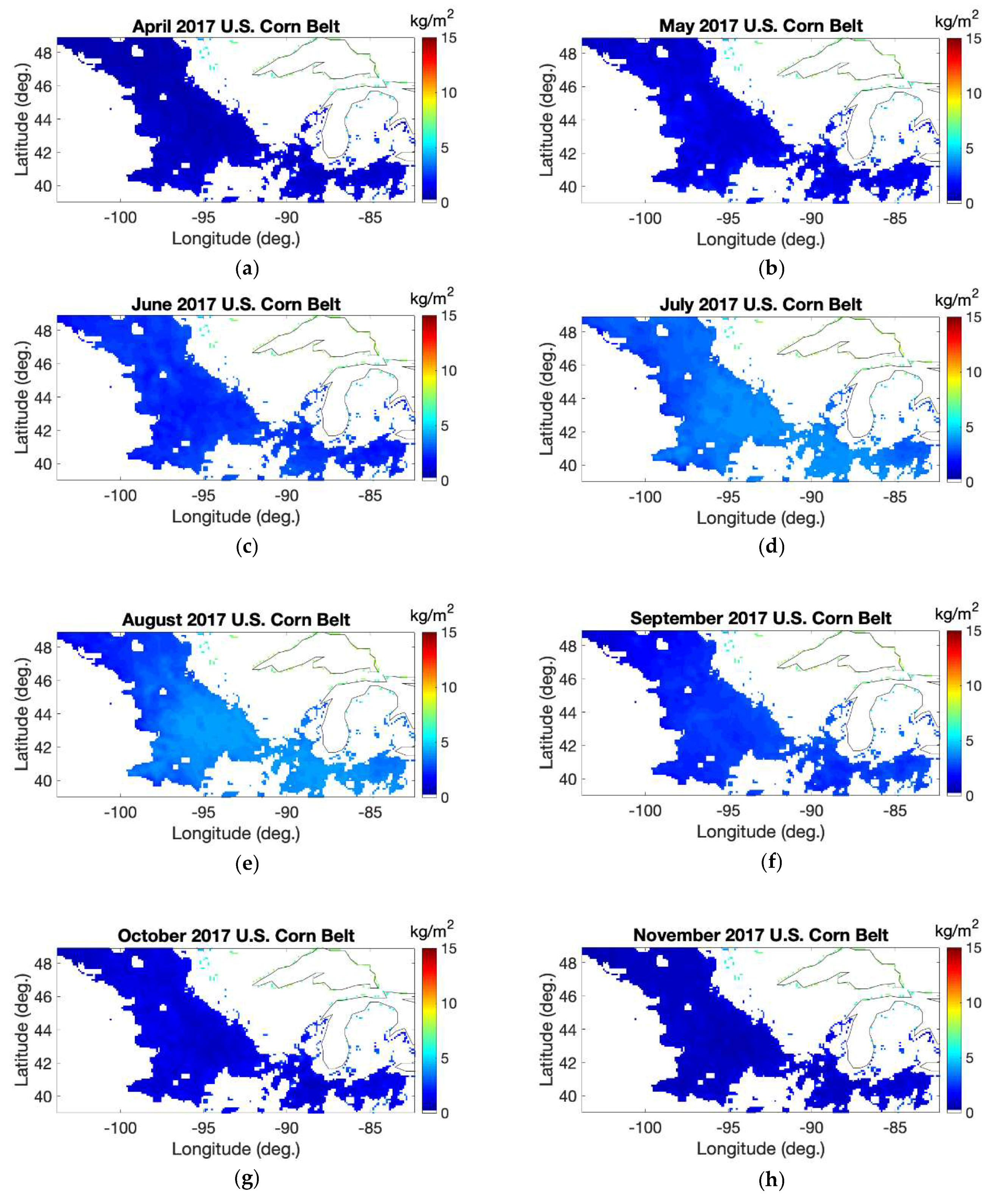
VOP Maps
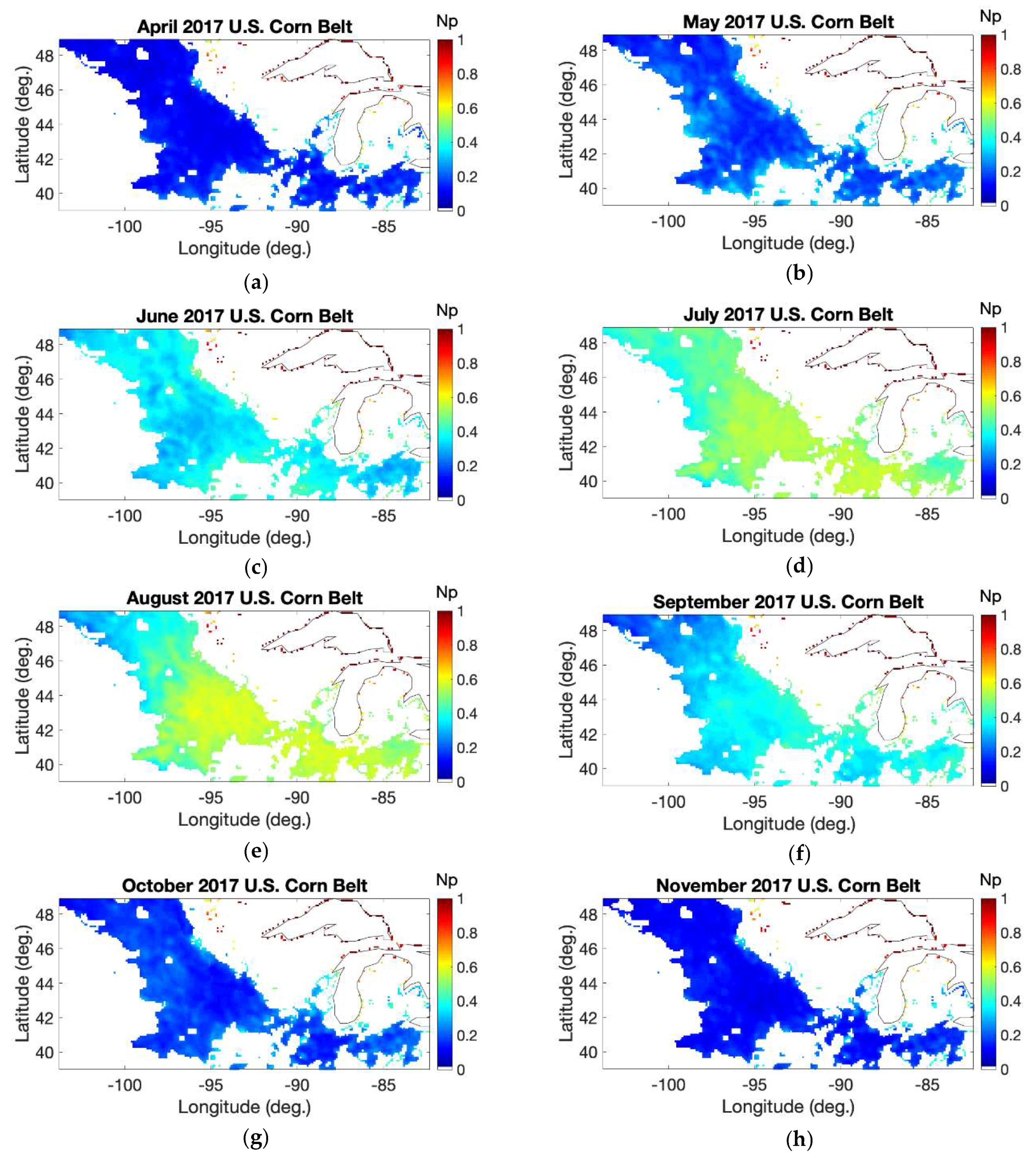
Appendix B
Crop Height Maps

References
- Entekhabi, D. The Soil Moisture Active Passive (SMAP) mission. Proc. IEEE 2010, 98, 704–716. [Google Scholar] [CrossRef]
- Silvestrin, P.M.; Berger, Y.H.; Kerr, J. Font, ESA’s Second Earth Explorer Opportunity Mission: The soil Moisture and Ocean salinity Mission—SMOS. IEEE Geosci. Remote Sens. Newsl. 2001, 118, 11–14. [Google Scholar]
- O’Neill, P.E.; Chan, S.; Njoku, E.G.; Jackson, T.; Bindlish, R. SMAP Enhanced L3 Radiometer Global Daily 9 km EASE-Grid Soil Moisture, Version 2. Available online: https://nsidc.org/data/SPL3SMP_E/versions/3 (accessed on 20 March 2020).
- Centre Aval de Traitement des Données SMOS (CATDS). CATDS-PDC L3SM Aggregated—3-Day, 10-Day and Monthly Global Map of Soil Moisture Values from SMOS Satellite. Available online: https://www.catds.fr/Products/Available-products-from-CPDC/Catalogue/Catds-products-from-Sextant#/metadata/b57e0d3d-e6e4-4615-b2ba-6feb7166e0e6 (accessed on 9 March 2020).
- Chan, S.K. Development and assessment of the SMAP enhanced passive soil moisture product. Remote Sens. Environ. 2018, 204, 931–941. [Google Scholar] [CrossRef] [Green Version]
- Jackson, T.J.; Schmugge, T.J. Vegetation effects on the microwave emission from soils. Rem. Sens. Environ. 1991, 36, 203–212. [Google Scholar] [CrossRef]
- Salomonson, V.V.; Barnes, W.I.; Maymon, P.W.; Montgomery, H.; Ostrow, H. MODIS—Advanced Facility Instrument For Studies Of The Earth As A System. IEEE Trans. Geosci. Remote Sens. 1989, 27, 145–153. [Google Scholar] [CrossRef]
- Cosh, M.H.; White, W.A.; Colliander, A.; Jackson, T.J.; Prueger, J.H.; Hornbuckle, B.K.; Hunt, E.R.; McNairn, H.; Powers, J.; Walker, V.; et al. Estimating vegetation water content during the soil moisture active passive validation experiment in 2016. J. Appl. Remote Sens. 2019, 13, 2019. [Google Scholar] [CrossRef]
- Jackson, T.J.; le Vine, D.M.; Hsu, A.Y.; Oldak, A.; Starks, P.J.; Swift, C.T.; Isham, J.D.; Haken, M. Soil moisture mapping at regional scales using microwave radiometry: The Southern Great Plains hydrology experiment. IEEE Trans. Geosci. Remote Sens. 1999, 37, 2136–2151. [Google Scholar] [CrossRef] [Green Version]
- Dong, J.; Crow, W.T.; Bindlish, R. The error structure of the SMAP single- and dual-channel soil moisture retrievals. Geophys. Res. Lett. 2018, 45, 758–765. [Google Scholar] [CrossRef] [Green Version]
- Chew, C.; Lowe, S.; Parazoo, N.; Esterhuizen, S.; Oveisgharan, S.; Podest, E.; Zuffada, C.; Freedman, A. SMAP radar receiver measures land surface freeze/thaw state through capture of forward-scattered L-band signals. Remote Sens. Environ. 2017, 198, 333–344. [Google Scholar] [CrossRef]
- Carreno-Luengo, H.; Lowe, S.; Zuffada, C.; Esterhuizen, S.; Oveisgharan, S. Spaceborne GNSS-R from the SMAP Mission: First Assessment of Polarimetric Scatterometry over Land and Cryosphere. Remote Sens. 2017, 9, 362. [Google Scholar] [CrossRef] [Green Version]
- Rodriguez-Alvarez, N.; Podest, E. Characterization of the Land Freeze/Thaw State with SMAP-Reflectometry. In Proceedings of the IGARSS 2019–2019 IEEE International Geoscience and Remote Sensing Symposium, Yokohama, Japan, 28 July–2 August 2019; pp. 4024–4027. [Google Scholar] [CrossRef]
- Rodriguez-Alvarez, N.; Misra, S.; Morris, M. Sensitivity Analysis of SMAP-Reflectometry (SMAP-R) Signals to Vegetation Water Content. In Proceedings of the IGARSS 2019–2019 IEEE International Geoscience and Remote Sensing Symposium, Yokohama, Japan, 28 July–2 August 2019; pp. 7395–7398. [Google Scholar] [CrossRef]
- Rodriguez-Alvarez, N.; Misra, S.; Podest, E.; Morris, M.; Bosch-Lluis, X. The Use of SMAP-Reflectometry in Science Applications: Calibration and Capabilities. Remote Sens. 2019, 11, 2442. [Google Scholar] [CrossRef] [Green Version]
- Njoku, E.; Li, L. Retrieval of land surface parameters using passive microwave measurements at 6-18 GHz. IEEE Trans. Geosci. Remote Sens. 1999, 37, 79–93. [Google Scholar] [CrossRef] [Green Version]
- Guerriero, L.; Pierdicca, N.; Pulvirenti, L.; Ferrazzoli, P. Use of Satellite Radar Bistatic Measurements for Crop Monitoring: A Simulation Study on Corn Fields. Remote Sens. 2013, 5, 864–890. [Google Scholar] [CrossRef] [Green Version]
- Carreno-Luengo, H.; Amèzaga, A.; Vidal, D.; Olivé, R.; Munoz, J.F.; Camps, A. First Polarimetric GNSS-R Measurements from a Stratospheric Flight over Boreal Forests. Remote Sens. 2015, 7, 13120–13138. [Google Scholar] [CrossRef] [Green Version]
- Motte, E. GLORI: A GNSS-R Dual Polarization Airborne Instrument for Land Surface Monitoring. Sensors 2016, 16, 732. [Google Scholar] [CrossRef]
- NASA Earthdata Website. Available online: https://earthdata.nasa.gov (accessed on 18 March 2020).
- Zavorotny, V.U.; Voronovich, A.G. Scattering of GPS signals from the ocean with wind remote sensing application. IEEE Trans. Geosci. Remote Sens. 2000, 38, 951–964. [Google Scholar] [CrossRef] [Green Version]
- Voronovich, A.G.; Zavorotny, V.U. Bistatic radar equation for signals of opportunity revisited. IEEE Trans. Geosci. Remote Sens. 2018, 56, 1959–1968. [Google Scholar] [CrossRef]
- Ruf, C.S. The CYGNSS nanosatellite constellation hurricane mission. In Proceedings of the 2012 IEEE International Geoscience and Remote Sensing Symposium, Munich, Germany, 22–27 July 2012; pp. 214–216. [Google Scholar] [CrossRef]
- Ruf, C.S. CYGNSS: Enabling the Future of Hurricane Prediction Remote Sensing Satellites. IEEE Geosci. Remote Sens. Mag. 2013, 1, 52–67. [Google Scholar] [CrossRef]
- Ruf, C.S.; Atlas, R.; Chang, P.S.; Clarizia, M.P.; Garrison, J.L.; Gleason, S.; Katzberg, S.J.; Jelenak, Z.; Johnson, J.T.; Majumdar, S.J.; et al. New Ocean Winds Satellite Mission to Probe Hurricanes and Tropical Convection. Bull. Amer. Meteor. Soc. 2016, 97, 385–395. [Google Scholar] [CrossRef]
- Ruf, C.S.; Scherrer, J.; Rose, R.; Provost, D. Algorithm Theoretical Basis Document Level 1B DDM Calibration. Available online: https://clasp-research.engin.umich.edu/missions/cygnss/reference/ATBD%20L1B%20DDM%20Calibration%20R1.pdf (accessed on 20 March 2020).
- Owe, M.; de Jeu, R.; Walker, J. A methodology for surface soil moisture and vegetation optical depth retrieval using the microwave polarization difference index. IEEE Trans. Geosci. Remote Sens. 2001, 39, 1643–1654. [Google Scholar] [CrossRef] [Green Version]
- U.S. Department of Agriculture National Agricultural Statistics Service Database. Available online: https://www.nass.usda.gov/Charts_and_Maps/Crops_County/cr-pl.php (accessed on 20 March 2020).
- Neeser, C.; Dille, J.; Krishnan, G.; Mortensen, D.; Rawlinson, J.; Martin, A.; Bills, L. WeedSOFT®: A weed management decision support system. Weed Sci. 2004, 52, 115–122. [Google Scholar] [CrossRef]
- U.S. Department of Agriculture National Agricultural Statistics Service Database CropScape—Cropland Data. Available online: https://nassgeodata.gmu.edu/CropScape/ (accessed on 20 March 2020).
- Colliander, A. Vegetation & Roughness Parameters. SMAP Report, JPL D-53065.
- Peng, J.; Mohammed, P.; Chaubell, J.; Chan, S.; Kim, S.; Das, N.; Dunbar, S.R.B.; Xu, X. Soil Moisture Active Passive (SMAP) L1-L3 Ancillary Static Data, Version 1. Available online: https://nsidc.org/data/SMAP_L1_L3_ANC_STATIC/versions/1 (accessed on 20 March 2020).
- Zobeck, T.M.; Onstad, C.A. Tillage and rainfall effects on random roughness: A review. Soil Till. Res. 1987, 9, 1–20. [Google Scholar] [CrossRef]
- Choudhury, B.J.; Schmugge, T.J.; Chang, A.; Newton, R.W. Effect of surface roughness on the microwave emission from soil. J. Geophys. Res. 1979, 84, 5699–5706. [Google Scholar] [CrossRef]
- Wang, J.R. Passive microwave sensing of soil moisture content: The effects of soil bulk density and surface roughness. Remote Sens. Environ. 1983, 13, 329–344. [Google Scholar] [CrossRef]
- SMAP Algorithm Theoretical Basis Document: L2 & L3 Radiometer Soil Moisture (Passive) Products. Available online: https://nsidc.org/sites/nsidc.org/files/technical-references/L2_SM_P_ATBD_v7_Sep2015-po-en.pdf (accessed on 20 March 2020).
- Chan, S. Vegetation Water Content. JPL D-53061. Available online: https://www.google.com/url?sa=t&rct=j&q=&esrc=s&source=web&cd=2&ved=2ahUKEwiR-eD2n6noAhVUvJ4KHQ6pB2gQFjABegQIAxAB&url=https%3A%2F%2Fsmap.jpl.nasa.gov%2Fsystem%2Finternal_resources%2Fdetails%2Foriginal%2F289_047_veg_water.pdf&usg=AOvVaw1ccuGfDNPM6-rdRqF2_SSj (accessed on 20 March 2020).
- U.S. Department of Agriculture National Agricultural Statistics Service database VegScape—Vegetation Condition Explorer. Available online: https://nassgeodata.gmu.edu/VegScape/ (accessed on 20 March 2020).
- Hunt, E.R., Jr.; Piper, S.C.; Nemani, R.; Keeling, C.D.; Otto, R.D.; Running, S.W. Global net carbon exchange and intra-annual atmospheric CO2 concentrations predicted by an ecosystem process model and three-dimensional atmospheric transport model. Glob. Biogeochem. Cycles 1996, 10, 431–456. [Google Scholar] [CrossRef] [Green Version]
- Togliatti, K.T.; Hartman, T.; Walker, V.A.; Arkebaur, T.J.; Suyker, A.E.; VanLoocke, A.; Hornbuckle, B.K. Satellite L–band vegetation optical depth is directly proportional to crop water in the US Corn Belt. Remote Sens. Environ. 2019, 223, 111. [Google Scholar] [CrossRef]
- Berglund, D.R. Corn Growth and Management Quick Guide—A1173. North Dakota State University Extension Service. Available online: https://www.ag.ndsu.edu/pubs/plantsci/rowcrops/a1173.pdf (accessed on 21 March 2020).
- Wise, K. Managing Wheat by Growth Stage. Purdue Extension, ID-422. Available online: https://www.extension.purdue.edu/extmedia/ID/ID-422.pdf (accessed on 21 March 2020).
- Berglund, D.R. Soybean Growth and Management Quick Guide—A1174, North Dakota State University. Available online: https://www.ag.ndsu.edu/pubs/plantsci/rowcrops/a1174.pdf (accessed on 21 March 2020).
- Hornbuckle, B.K.; Patton, J.C.; VanLoocke, A.; Suyker, A.E.; Roby, M.C.; Walker, V.A.; Iyer, E.R.; Herzmann, D.E.; Endacott, E.A. SMOS optical thickness changes in response to the growth and development of crops, crop management, and weather. Remote Sens. Environ. 2016, 180, 320–333. [Google Scholar] [CrossRef] [Green Version]
- Kendall, M.G. The Advanced Theory of Statistics, Inference and relationship, 4th ed.; Charles Griffin: London, UK, 1979; Volume 2. [Google Scholar]
- Didan, K. Mod13q1 Modis/Terra Vegetation Indices 16-Day L3 Global 250 m SIN Grid V006. Distributed by NASA Eosdis Land Processes DAAC. Available online: https://lpdaac.usgs.gov/products/mod13q1v006/ (accessed on 25 September 2019).
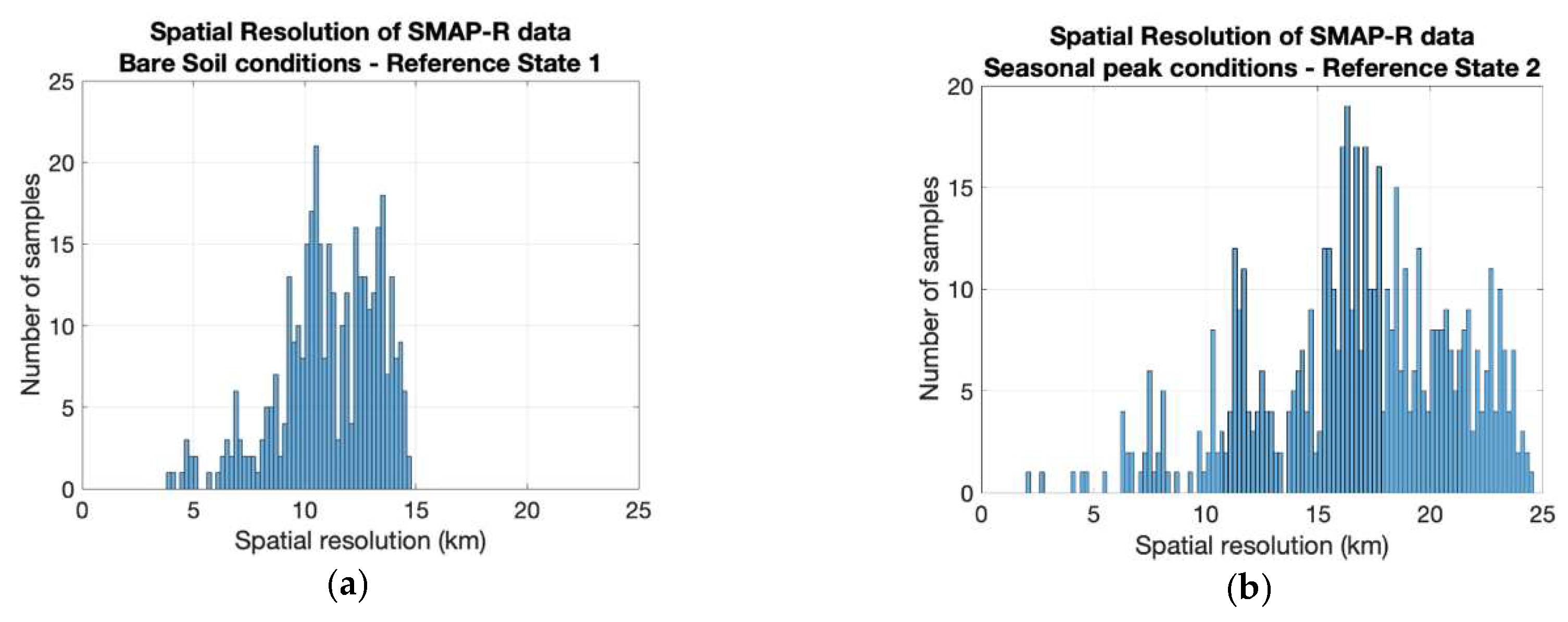





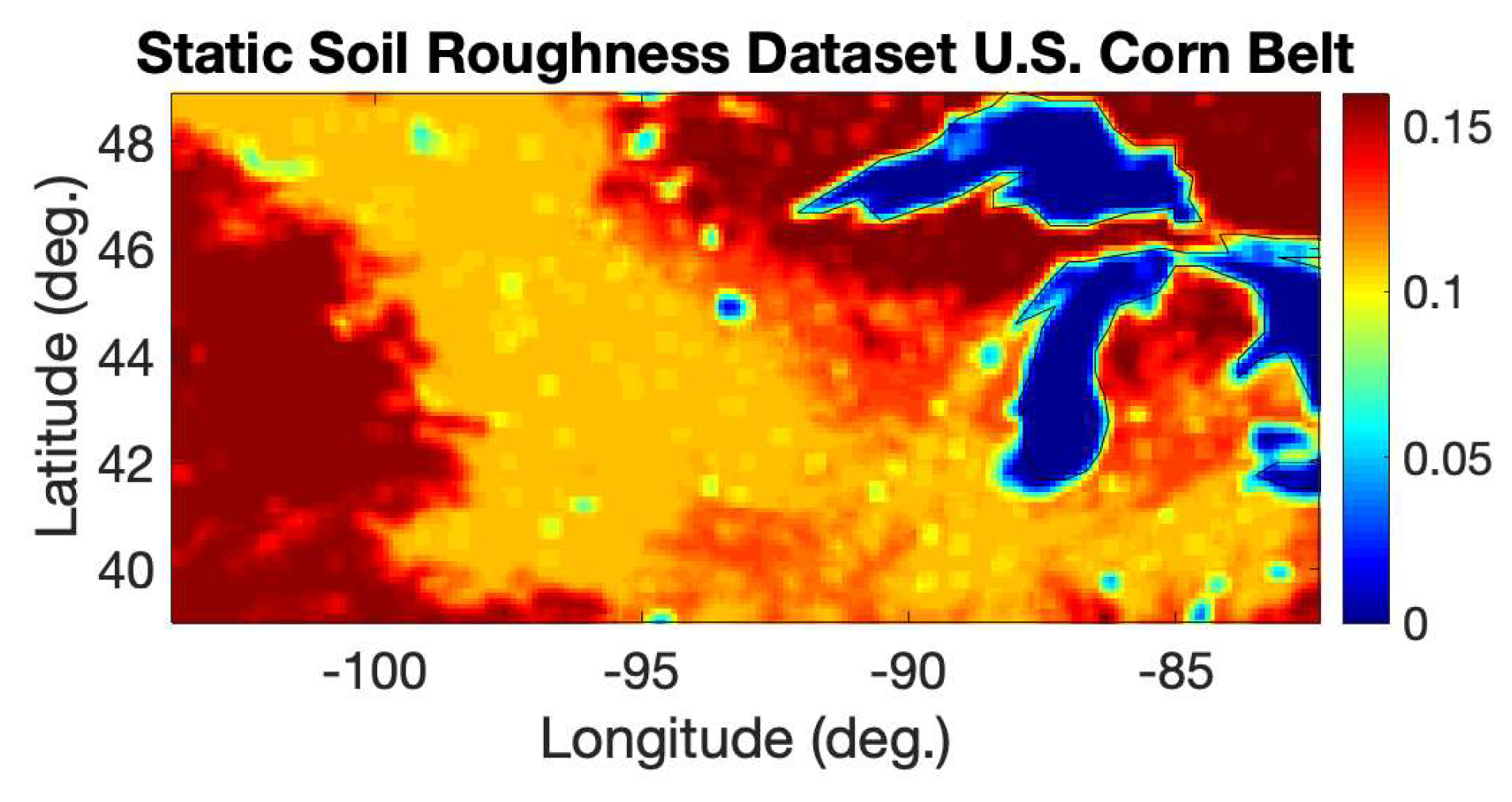

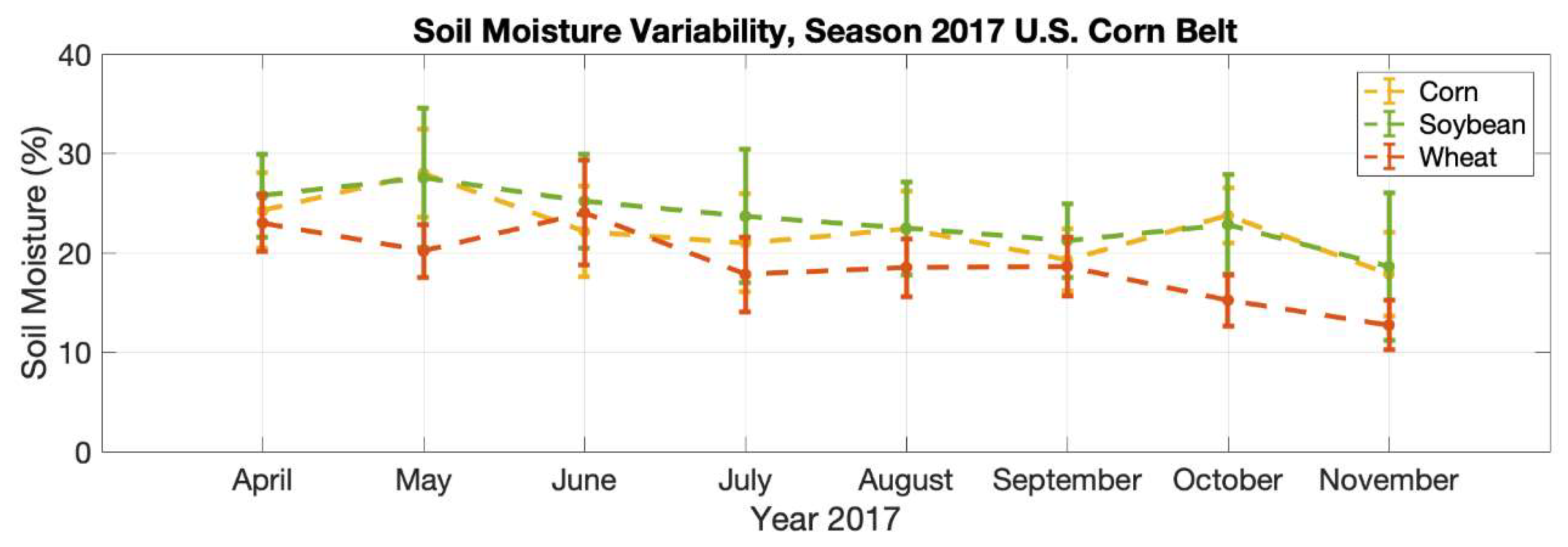
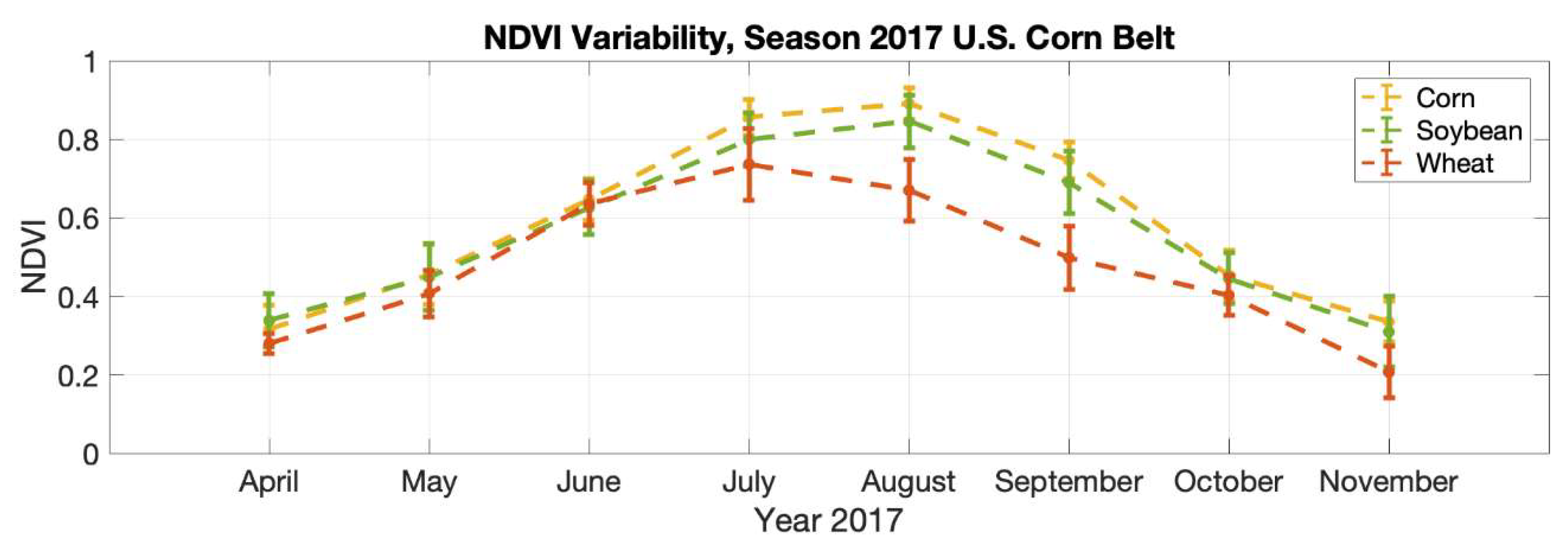
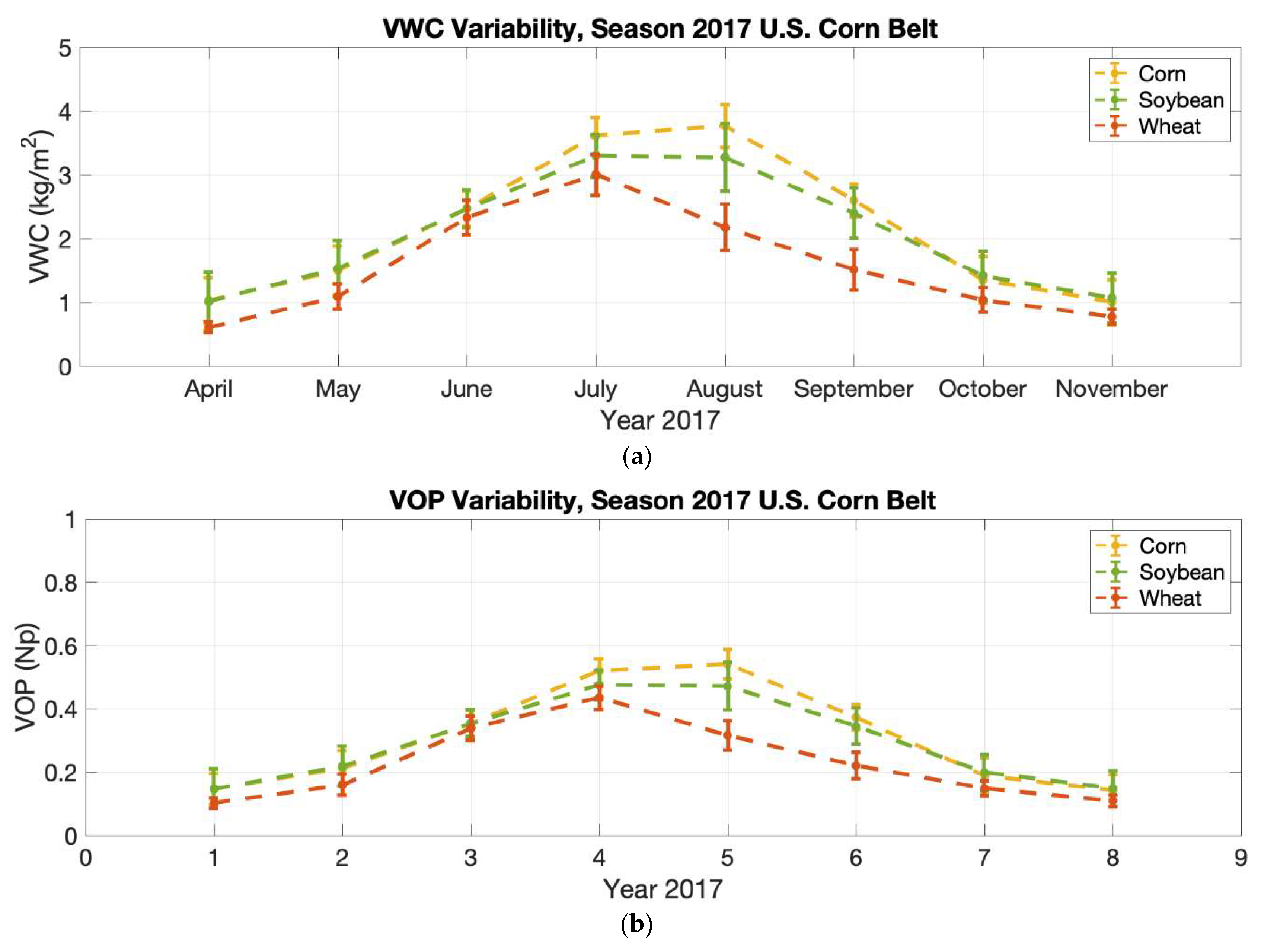
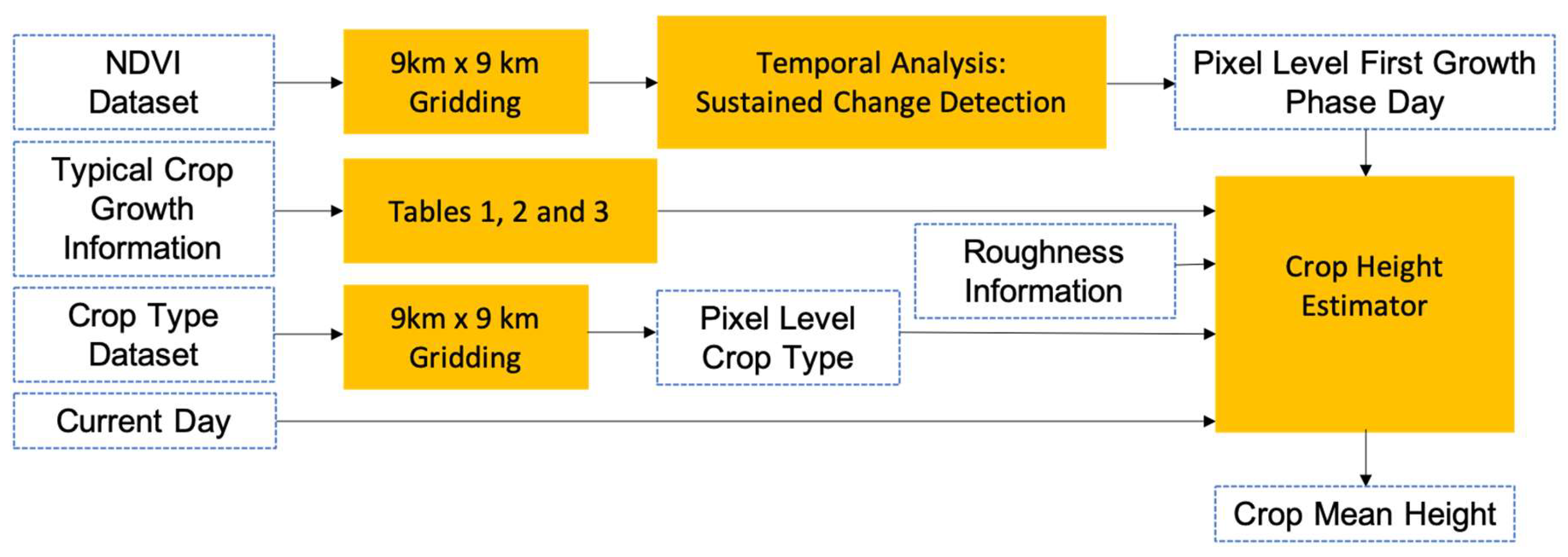
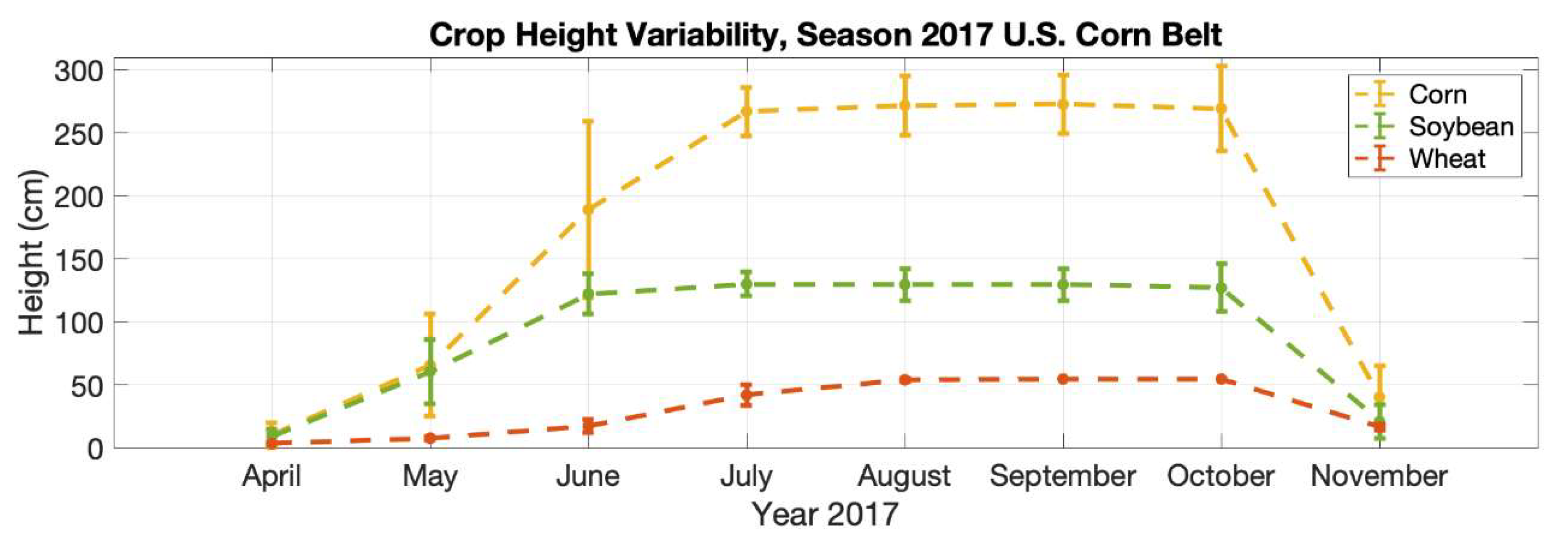


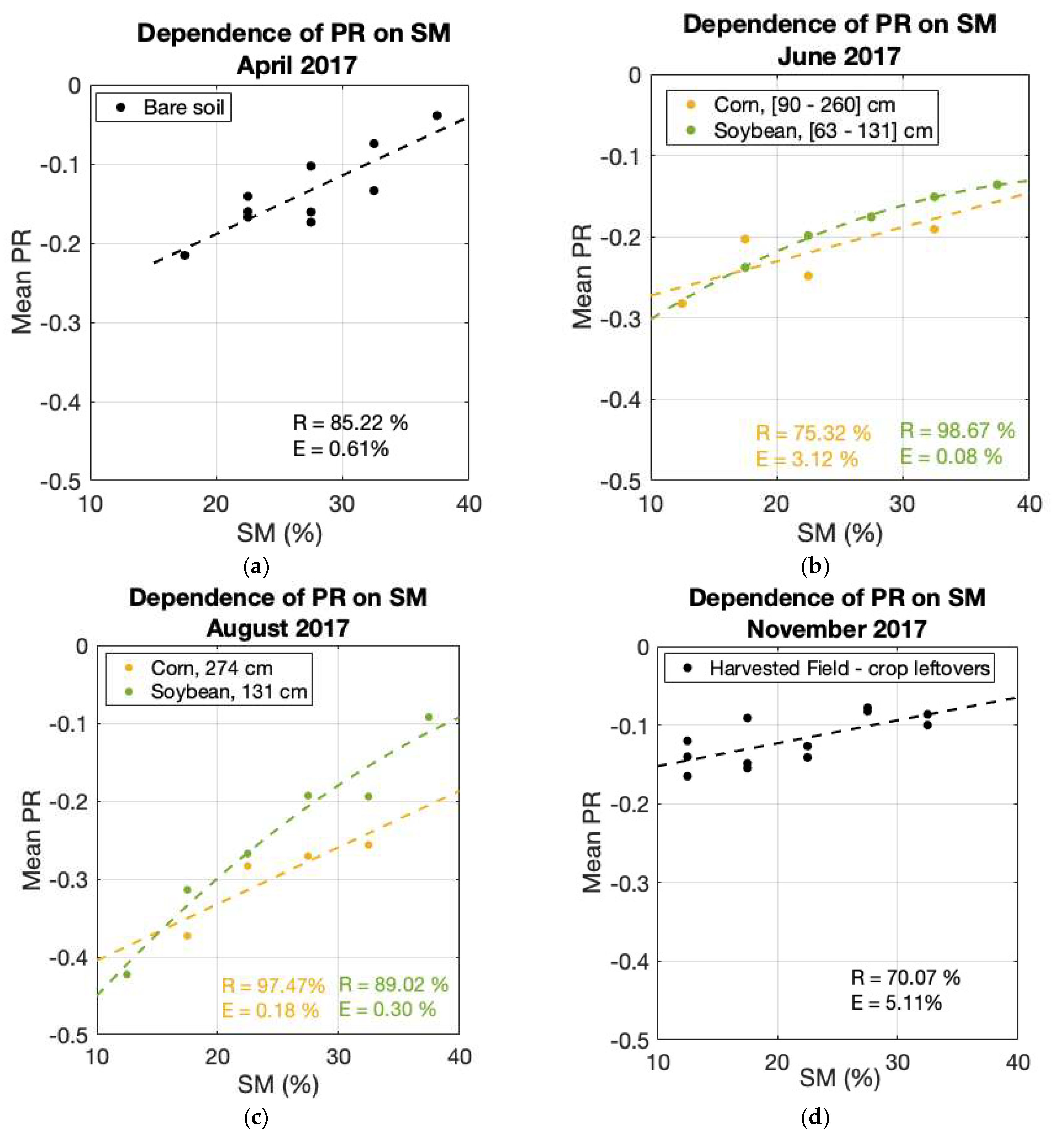
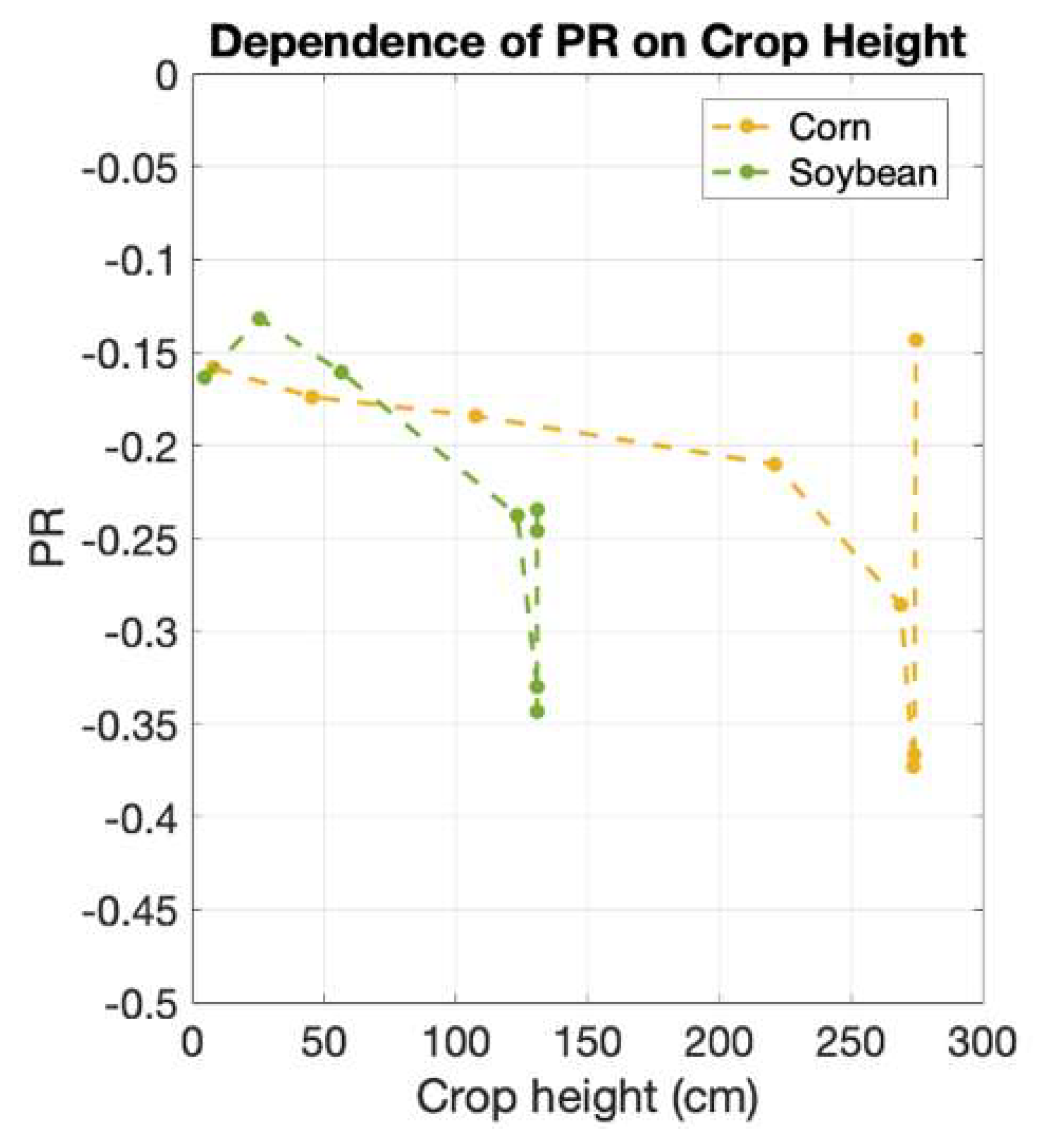
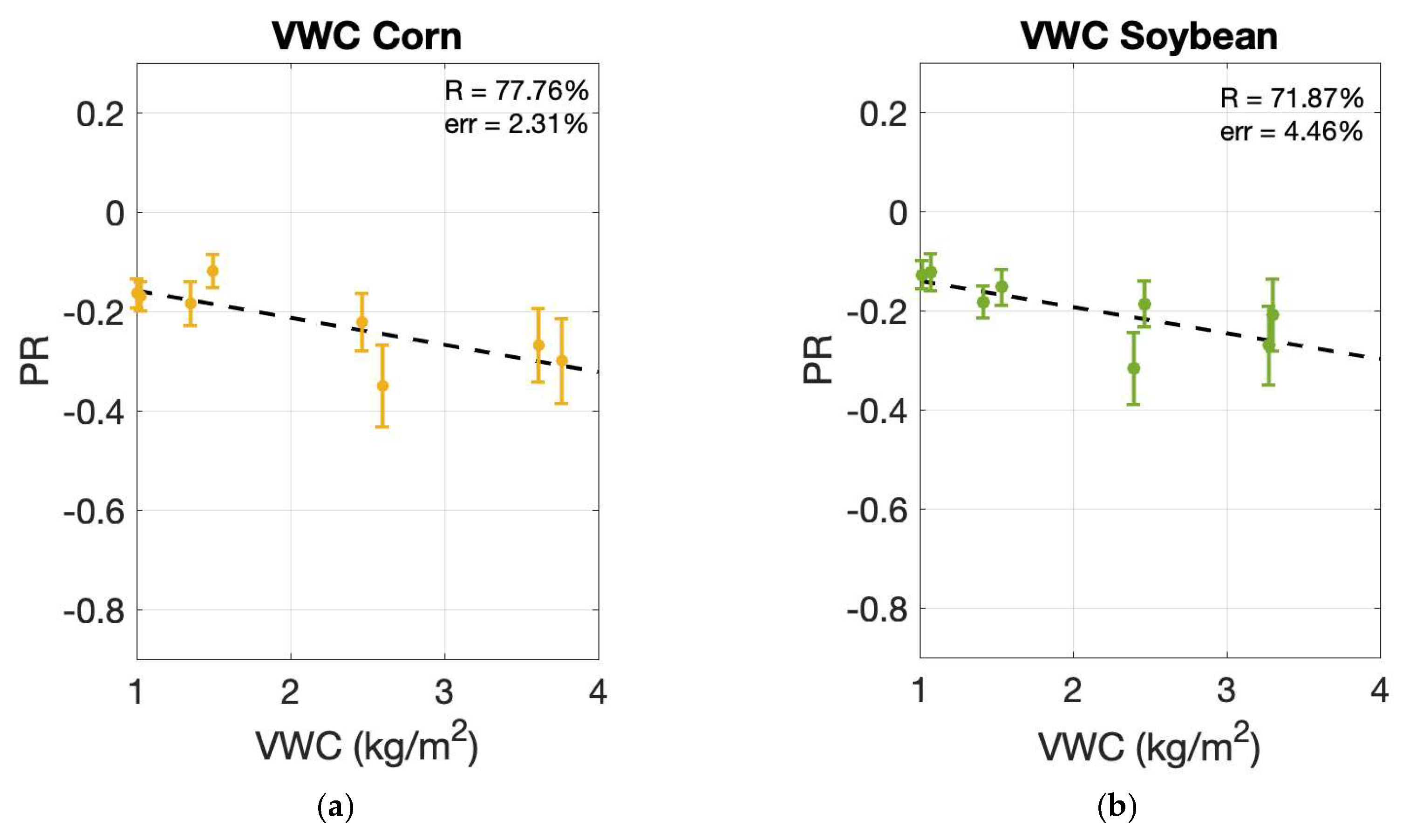
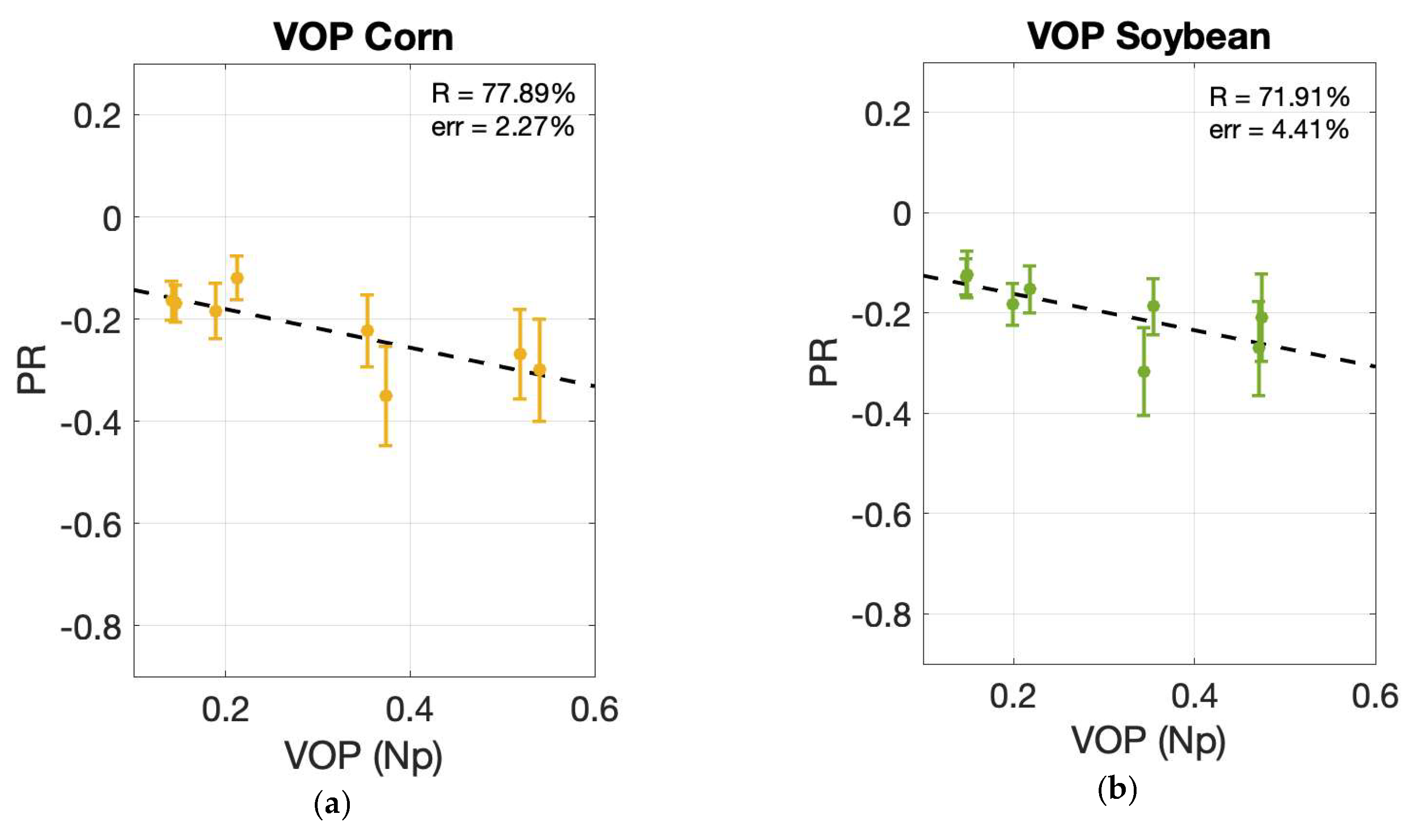
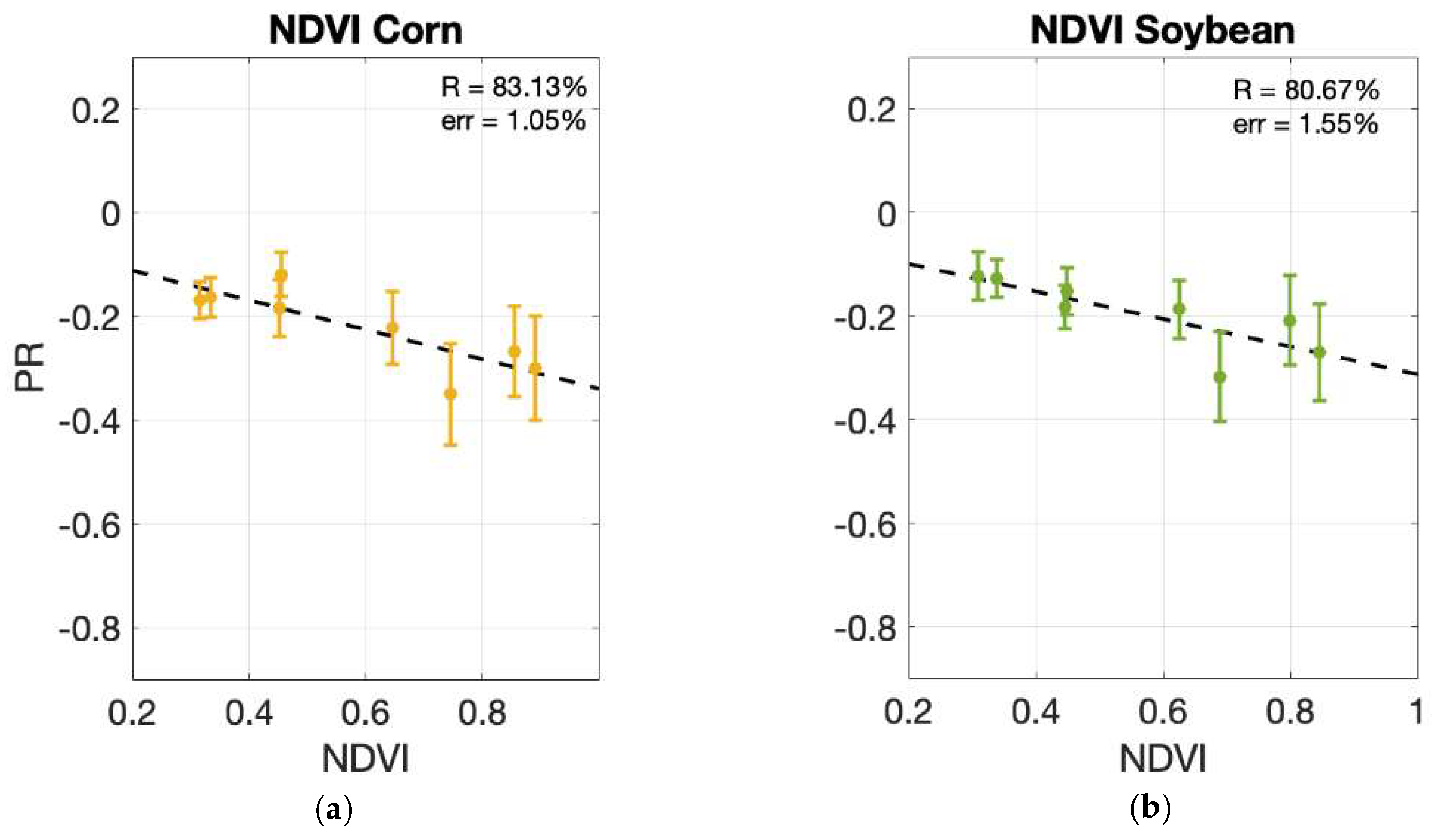
| Growth Stage | Height (cm) | Days |
|---|---|---|
| Emergence (VE) | 0 | 0 |
| 1 leaves (V1) | 5 | 7 |
| 5 leaves (V5) | 14 | 14 |
| 8 leaves (V8) | 48 | 28 |
| 12 leaves (V12) | 89 | 42 |
| 16 leaves (V16) | 125 | 56 |
| 18/21 leaves (V18/V21) Tassel and silk (VT) | 250 | 66 |
| Reproductive stages (R1-R5) | 260–275 | 70–120 |
| Maturity (R6) | 275 | 126 |
| Growth Stage | Height (cm) | Days |
|---|---|---|
| Emergence (1) | 0 | 0 |
| Tillering (2) | 3 | 7 |
| Tillers formed (3) | 6 | 25 |
| Tillers erect (4) | 9 | 50 |
| Tillers strong (5) | 12 | 60 |
| First node (6) | 16 | 70 |
| Second node (7) | 21 | 75 |
| Last leaf (8) | 27 | 85 |
| Ligule visible (9) | 35 | 90 |
| Boot, head swollen (10) | 44 | 98 |
| Heading (10.1) | 47 | 105 |
| Flowering (10.5) | 51 | 110 |
| Ripening (11) | 55 | 125 |
| Growth Stage | Height (cm) | Days |
|---|---|---|
| Emergence (VE) | 0 | 0 |
| Unrolled unifoliate (VC) | 3 | 7 |
| 1 trifoliate developed (V1) | 8.65 | 13 |
| 2 trifoliate developed (V2) | 18.18 | 19 |
| 3 trifoliate developed (V3) | 27.71 | 25 |
| 4 trifoliate developed (V4) | 37.23 | 31 |
| 5/6 trifoliate developed (V5/V6) | 46.76 | 37 |
| Flowering (R1-R2) | 53.11–129 | 41–57 |
| Pod development (R3-R4) | ||
| Seed filling (R5-R6) | ||
| Maturity (R7-R8) | 131 | 61–100 |



© 2020 by the authors. Licensee MDPI, Basel, Switzerland. This article is an open access article distributed under the terms and conditions of the Creative Commons Attribution (CC BY) license (http://creativecommons.org/licenses/by/4.0/).
Share and Cite
Rodriguez-Alvarez, N.; Misra, S.; Morris, M. The Polarimetric Sensitivity of SMAP-Reflectometry Signals to Crop Growth in the U.S. Corn Belt. Remote Sens. 2020, 12, 1007. https://0-doi-org.brum.beds.ac.uk/10.3390/rs12061007
Rodriguez-Alvarez N, Misra S, Morris M. The Polarimetric Sensitivity of SMAP-Reflectometry Signals to Crop Growth in the U.S. Corn Belt. Remote Sensing. 2020; 12(6):1007. https://0-doi-org.brum.beds.ac.uk/10.3390/rs12061007
Chicago/Turabian StyleRodriguez-Alvarez, Nereida, Sidharth Misra, and Mary Morris. 2020. "The Polarimetric Sensitivity of SMAP-Reflectometry Signals to Crop Growth in the U.S. Corn Belt" Remote Sensing 12, no. 6: 1007. https://0-doi-org.brum.beds.ac.uk/10.3390/rs12061007




